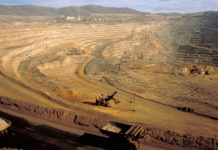
[miningmx.com] — ANGLOGOLD Ashanti aims to use new technology to go 5km below the surface to unlock 70 million ounces, a conference heard on Monday.
The drive to a $125bn resource will see blasting eliminated and remove humans from the stopes where gold is extracted, Mike MacFarlane, AngloGold’s senior vice president for technology, told a mining automation conference.
“Gold production is in decline. Our aim is to arrest that decline or even increase production,” he said.
“We are standing on the edge of a major shift in the way people think about underground mining. And it’s a shift that you see just once in a 30 to 40-year timeframe,” he said.
AngloGold currently operates the world’s deepest mines and its Mponeng operation is about 4km deep. But MacFarlane said tens of millions of ounces could not be accessed and so “was not making any money and there is no pull for investment”.
South Africa’s mines are not only the deepest in the world but are also among the most dangerous.
The country’s mines minister recently described the death toll as “carnage” and said there was a link between the pursuit of profits and the body count.
With safety a huge concern as South African gold miners go deeper, MacFarlane said AngloGold was aiming to “remove people from high risk activities … The driver of this project has been safety”.
NO MORE BLASTING
This would involve replacing blasting with machines to mechanically cut the rock and removing workers from the narrow passages known as stopes in the next three to five years.
It is in the stopes where a lot of fatalities happen and MacFarlane said the aim was to replace humans using tools with machines “so that nobody would be exposed”.
“We would like in three to five years to have a working model underground where we can start the transition to bring this non-blasting approach across our entire operations,” he told Reuters on the sidelines of the conference.
Such changes would also enable the company to increase its extraction rates from around eight grams per tonne to 16 grams or more.
This is because the stopes currently must be 1.5 metres (5 feet) high to accommodate a person, while the ore body is about 60 cms (2 feet).
A machine can extract from the body itself without the additional tonnage in waste that must be pulled out to fit a human operator.
Such technology may be needed to go safely to new depths but it could also cost jobs, which is a sensitive topic in a country of 50 million with an unemployment rate of over 25%. South Africa’s mines are a crucial source of employment with a workforce of around 500,000.
Still, it could bring a lot more gold to the surface.
“This will potentially unlock 70 million ounces,” MacFarlane told Reuters. At today’s spot price over $1,800 an ounce that would mean over $125bn worth of gold.
Gold’s record run has made companies look at new frontiers and sparked a wave of research and development activity.
Gold Fields, the world’s fourth largest gold producer, is looking at robots and other technology to boost safety and cut costs as it too digs deeper. Its chief executive hinted in a recent interview with Reuters that the company would soon make a major technological announcement or breakthrough.









